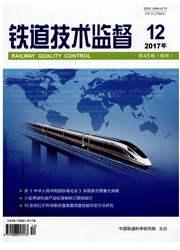

 中文摘要:
中文摘要:
根据中俄铁路碎石道砟标准,对道砟物理性能指标及试验进行对比研究,得出如下主要结论:①中俄两国铁路线路条件、气候及道砟资源存在差异,故制定指标的侧重点不同;②中俄两国对集料冲击韧度试验的计算指标不同,俄罗斯标准对颗粒粉碎状况的反映不如我国试验精确、全面;③中俄两国道砟试验所用筛网尺寸、形状均有差异,我国试验仅采用方孔筛,俄罗斯试验兼用方孔筛和圆孔筛,这些差异会影响试验结果;④俄罗斯道砟试验所用样品与建设所用道砟针片状指数相同,我国标准将试样针片状指数控制在5%以内,以便对比母材差异;⑤我国硫酸钠溶液浸泡损失率试验的循环次数与当前试验循环样本浸泡质量损失率无关,俄罗斯试验最终循环次数与当前试验循环的样本质量损失率相关;⑥俄罗斯标准对道砟电导率、天然放射性核素比活度、玄武岩集料冲击韧度试验后,经煮沸处理的样本质量损失率等有特殊要求。
 英文摘要:
英文摘要:
According to the railway ballast standards available in China and Russia, by comparing and studying the physical property index and test on ballasts, some key conclusions are made as follows: ① Because of differences in railway line conditions, climates and ballast resources between China and Russia, the emphasis points applied to de- velop the index are different; ② The calculating indexes applied to the aggregate impact toughness test are different for China and Russia. The Russian standard fails to represent impacted aggregate fragmentation in a manner as accu- rate and complete as its Chinese counterpart does ; ③The sizes and shapes of sieves used for the ballast test are differ- ent between Chinese and Russian. Only square-opening sieves are used in China while both square and circular open- ing sieves are used in Russia. All these differences can affect the test results ; ④ Samples used for the ballast test in Russia are same to those used for construction in view of the ballast-specific needle-or flake-like indexes. In the do- mestic standard, the needle- or flake-like are controlled to up to 5% in order to compare the differences in base met- als; ⑤The cycles of the domestic mass loss rate test on rock using sodium sulfate solution immersion are not related to the mass loss rate of current immersed samples recycled in the test. The final cycles for the Russian tests however, are related to the mass loss rate of current immersed samples recycled in the test; ⑥ Special requirements are pro- posed in the Russian standard in view of mass loss rate of boiled samples that have undergone tests on ballast conduc- tivity, specific activity of specific activity of natural radioactive nuclides and basatt aggregate impact toughness.
 同期刊论文项目
同期刊论文项目
 同项目期刊论文
同项目期刊论文
 期刊信息
期刊信息
